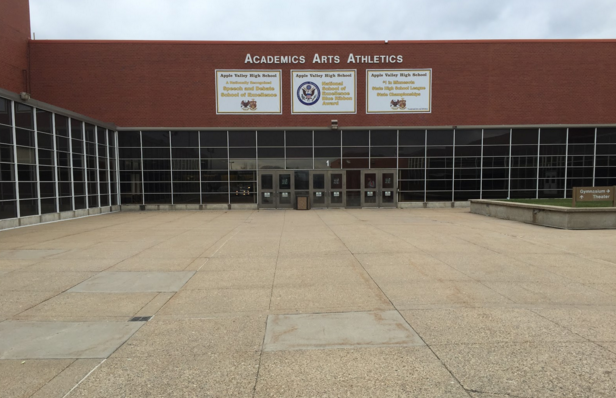Intra-What?
Current entrance to AVHS.
“Eastview. All the smart people go there.”
“No, Apple Valley. The best athletes go to school there.”
“No, dumby, Eastview.”
And then a kerfuffle ensues, teachers rein in the unruly students, and finally order is restored.
This scene is one rather familiar to Apple Valley students who may have attended Falcon Ridge Middle School. There, and in many Independent School District 196 schools, primary students argue ceaselessly about which school is better. This kind of strong partiality for one school over another is why ISD 196 allows intradistrict enrollment.
This type of enrollment gives students already living in ISD 196 the option to chose which high school they want to attend. If a student applies for intradistrict enrollment, they can do so for one of three reasons: they will be moving to a different attendance area soon, they are a junior or senior in high school and they moved recently (this provides continuity), or a parent or guardian requests it.
According to ISD 196 Superintendent Jane Berenz, “[The] administration and the school board think that school choice is an important option for families…We want to offer choice as an option for District 196 families and we can facilitate that by offering intradistrict enrollment.” This allows parents to choose where their child is going to school, and gives parents a larger role in their child’s education.

However, Apple Valley High School has been experiencing declining numbers. This year’s graduating class is 440 students. In comparison, Eastview High School has 555 students graduating this year. Furthermore, in the 2015-2016 school year, 529 students in the Apple Valley attendance area transferred into different high schools, while only 79 transferred in. Eastview transferred in 599, and transferred out a mere 266.
Plans to even out the attendance gap at Apple Valley include the E3 STEM program. Superintendent Berenz says, “We have implemented the STEM corridor in the southwest portion of our district and, judging from the popularity of that field of study, I anticipate enrollment rising at Valley Middle School of Stem and AVHS.”
The principal at Falcon Ridge, Noel Mehus, brings to light some other developments that may help to reduce the rivalry between the two schools, which started at the grassroots level: “[Falcon Ridge has] been doing…the OVAIS (anti-bullying) curriculum… So that I think has made a big difference… in fights (at FRMS). It’s just non-existent compared to when I first started 12 years ago.”
He also noted that the number of student in the middle school wearing high school apparel seems to have dropped, and that school unity at FRMS seems to be on the rise, instead of the Apple Valley vs. Eastview disparity that he saw frequently in years past.

Michael Bolsoni, the principal at Apple Valley, spoke to the declining numbers and diversity within the AVHS general population as a strength, pointing out that everyone is noticing:
“Colleges try to diversify their college campuses…Companies that have diverse teams and companies that have diverse corporate boards actually perform higher and at better rates than companies that look the same…It is a strength of [Apple Valley’s]. It’s something that colleges recognize, and it’s something that our families recognize too.”
According to Bolsoni, the feeder schools for Apple Valley–Valley Middle School, and Cedar Park–have waiting lists for the first times. “(Families) are calling about STEM all the time. They want to be in our Fab Lab. They want to be part of our internships and things that are happening (at AVHS).”
While intradistrict enrollment once may have consigned Apple Valley to rise and ebb with the socio-economic pattern, the greatest strength of Apple Valley now seems to lie in what used to be perceived as its greatest weakness: diversity. The coming together of people from all walks of life to give students, in every sense of the word, an education.








